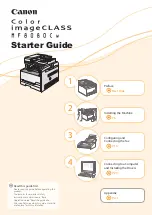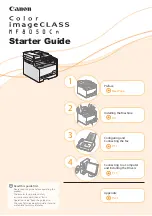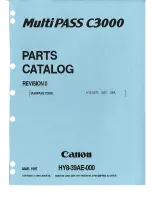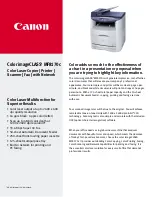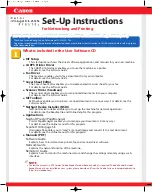
13–39
Chapter 13 – Troubleshooting Guide
Follow the procedures for fuser testing in Chapter 7,
Fuser Subsystem. These procedures are
very helpful in learning how the fuser works and in determining what component is at fault.
Look through the cooling holes in the rear of the top cover of the printer to see if the lamp is lit
during the warmup cycle. This will help to isolate the problem.
If the fuser is
underheating and does not reach the correct temperature in a fixed amount of
time, an error will occur. If the fuser
overheats, it will cause the thermal breaker to trip, and the
lamp will not light at all.
a. Follow these steps if the lamp is lit during the warmup cycle:
1) Make sure the thermistor does not have excessive toner buildup on it, which
will cause overheating. Clean or replace the thermistor.
NOTE:
In a normal overheating condition, the thermal breaker will trip when the
fuser temperature reaches the tripping point of the breaker. When there is
toner buildup on the thermistor, the temperature will exceed the breaker’s
trip point, and the breaker will trip. This stops the flow of current to the
lamp, and the fuser will no longer heat.
2) The thermistor itself is not functioning correctly, and must be replaced. It may
be intermittent, or it may be sending erroneous information.
3) The Digital-to-Analog converter for the thermistor is faulty. The Engine
Controller Board must be replaced.
4) The reference resistor on the fuser sensor board is faulty. This resistor sets the
reference voltage for the desired fusing temperature. The fuser sensor board
must be replaced.
5) The Data Controller Board is requesting status from the Engine Controller
Board too often. The Data Controller Board is requesting status information
from the Engine Controller Board at a rate faster than once every 10 ms (may
vary depending on the controller). The Engine Controller Board does not have
time to perform the Digital-to-Analog and Analog-to-Digital conversions for the
fuser temperature circuitry. The Data Controller Board must be replaced.
b. Follow these steps if the lamp is not lighting:
1) The thermal breaker has tripped due to an overheat condition. Remove the
breaker, measure its resistance, and replace it if it is open (infinite resistance).
2) The lamp is open or broken. Check its resistance to see if it is open, and
replace the lamp if its resistance is more than 2 ohms.
3) Fuse F2 is blown in the L.V.P.S. This prevents 110 V (or 220 V) from being
supplied to the lamp.
4) The thermistor is faulty and must be replaced. Disconnect its cable from the
fuser sensor board and measure its resistance. Make sure the thermistor is
not open.
5) The Fuser Sensor Board is faulty and must be replaced.
6) The Digital-to-Analog converter is faulty and the Engine Controller Board must
be replaced.
28 BEAM DET FAIL—Call Service
1. A beam detect failure has occurred. This means that the LSU motor is spinning, but it is not
generating interrupts.
a. Check the wiring to the LSU. Repair any wiring problems found.
b. Replace the L.V.P.S.
c. Replace the LSU.
Summary of Contents for L1024
Page 1: ...R...
Page 2: ......
Page 3: ...R P N 704792 001 Rev C...
Page 18: ...1 8 Chapter 1 Introduction...
Page 19: ...2 1 Chapter 2 Clamshell Chapter 2 Clamshell Clamshell and Subassemblies...
Page 46: ...4 4 Chapter 4 Developer Subsystem...
Page 47: ...5 1 Chapter 5 Transfer Subsystem Chapter 5 Transfer Subsystem Transfer Charger...
Page 63: ...5 17 Chapter 5 Transfer Subsystem Detail 5 4 Removing the Lamp Connector...
Page 65: ...6 1 Chapter 6 Paper Feed Subsystem Chapter 6 Paper Feed Subsystem Paper Feed Subsystem...
Page 82: ...6 18 Chapter 6 Paper Feed Subsystem Step 3 Step 2 Detail 6 5 Removing Connectors...
Page 97: ...7 1 Chapter 7 Fuser Subsystem Chapter 7 Fuser Subsystem Fuser Subsystem...
Page 137: ...8 5 Chapter 8 Power Supplies 1 1 2 2 High Voltage Power Supply...
Page 144: ...8 12 Chapter 8 Power Supplies Figure 8 4 Removing the LVPS Cables...
Page 146: ...8 14 Chapter 8 Power Supplies 5 4 2 3 1 Figure 8 5 Removing the LVPS...
Page 147: ...8 15 Chapter 8 Power Supplies Cable Routing Figure 8 6 LVPS Cable Routing...
Page 150: ...8 18 Chapter 8 Power Supplies Figure 8 9 Removing the LVPS Cables...
Page 152: ...8 20 Chapter 8 Power Supplies 5 4 2 3 1 Figure 8 10 Removing the LVPS...
Page 153: ...8 21 Chapter 8 Power Supplies Cable Routing Figure 8 11 LVPS Cable Routing...
Page 199: ...10 1 Chapter 10 Control Panel Chapter 10 Control Panel Keypad LCD Control Panel...
Page 215: ...11 9 Chapter 11 Laser Scanning Unit LSU Subsystem Detail 11 1 Removing the Top Cover...
Page 225: ...12 5 Chapter 12 Covers Frame and Backplane Board 14 1 15 1 21 1 Hinge Covers...
Page 250: ...12 30 Chapter 12 Covers Frame and Backplane Board Figure 12 12 Removing Cables...
Page 252: ...12 32 Chapter 12 Covers Frame and Backplane Board 5 4 2 3 1 Figure 12 13 Removing the LVPS...
Page 269: ...12 49 Chapter 12 Covers Frame and Backplane Board Figure 12 27 Removing Cables...
Page 319: ...Appendix B Wire Data B 1 Appendix B Wire Data...
Page 322: ...Appendix B Wire Data B 4...
Page 327: ...C 5 Appendix C Continuous Form Stacker 15 2 10 1 Figure C 2...
Page 331: ...C 9 Appendix C Continuous Form Stacker 35 2 40 1 55 1 50 1 45 1 Figure C 4...
Page 333: ...C 11 Appendix C Continuous Form Stacker 60 2 Figure C 5...
Page 337: ...C 15 Appendix C Continuous Form Stacker 100 1 105 2 115 1 110 1 ROTATED 180 Figure C 7...
Page 349: ...C 27 Appendix C Continuous Form Stacker 1 2 Figure C 16 Removing the Vertical Frame Braces...
Page 371: ......
Page 372: ...704792 001C...


































